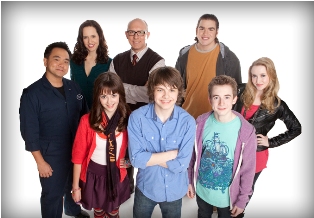Fresh, fast and fun: making multi-cam work for Mr. Young

When it comes to the production model for YTV’s Mr. Young, what’s old is new again.
The teen series, currently filming its second season in B.C., is shot in a multi-camera, live-audience format, a strategy that’s seen a resurgence in U.S. sitcoms but is a rarer breed on Canadian TV.
Ahead of a series of workshops for cast and crew, Playback spoke with Mr. Young producer Victoria Hirst of Vancouver-based Thunderbird Films about the benefits of multi-camera and adapting both talent and workflow to the new format.
The biggest plus to the new format is quick turnaround, more finely-tuned scripts and better performances from the young cast, says Hirst.
“You’ve got four cameras, so you’ve got four times the coverage, and in theory, it means that for your performers, who are younger, you can do less takes,” she explains, adding that the cast can hit their performances in the first three to four takes, whereas for a single-cam model, the same coverage can take 12 or 15 takes.
“Their performance is still fresher and funnier. It also means that you can get more pages a day. We’ve got two days where we are essentially doing a 44-page script,” she says.
“In film and television, I’ve never come across anything that’s been so instantaneous – and as a result, I think that our performers have really learned how to use that in their own performances and how to let go of one week and come in fresh for the next.”
A production week for Mr. Young includes two days of run-throughs and rewrites for the current week’s episode, says Hirst, and the final day starts with a morning rehearsal for the current week’s ep, followed by shooting it live in front of the studio audience.
Two days of run-throughs lets writers see their scripts in their entirety, “as if it’s a play,” says Hirst.
“It’s a real opportunity to analyze the words on the page and figure out what is not working before you get to shoot,” she explains. “Throughout the week, as the script has been evolving and rewritten, it’s funnier, the jokes are punchier.”
Shooting single-cam in TV limits the opportunity to hone scripts because the screenwriting is done before the actors come along, and there’s usually one read-through. Multi-cam, on the other hand, seems to be creating a fresher vibe on the Mr. Young set.
“Creatively, for both writers and performers, I would say it is the most satisfying format because you have the instant gratification of working all week and then having your payoff.”
Mr. Young showrunner Dan Signer (The Suite Life of Zack and Cody, The Suite Life on Deck) brought the format to the show, having worked with it for the Disney shows in L.A. and knowing it worked for younger performers.
But they were harder pressed to bring it to Canada, Hirst says, because of what she sees as a Canadian habit of steering clear of unpracticed and unfamiliar models. YTV, however, took a leap of faith.
“YTV was the first broadcaster that said ‘yes, let’s try it,’” says Hirst, adding that setting up required a lot of prep and visits to L.A. to learn the nuts and bolts.
“Season one was a huge learning curve for absolutely everyone. For season two, we maintained most of our season one crew, and now we’re fine-honed machine, but we need to build our talent base, and we know there’s more multi-cam coming down the pipeline,” she says.
Hirst says one of the most important things to know about this format from a production point of view is that things always change. That’s why they’re offering workshops next week for directors, writers, camera operators and other crew.
“What you think is going to be the script on day one is something different day two. For crew coming from single cam to multi-cam, they have to be flexible, adaptable and understand that all things change. [With single-cam, operators work with the DoP and focus puller second], and our operators do everything. Script supervisors, they’re looking at four cameras at all times so it’s training your eye to not look at one image, but four.”
It’s this same adaptability that also let the crew take on a tapeless postpro workflow, augmenting the quick turnaround time because the show’s editing is done on-site.
“It’s just about thinking in a different format,” says Hirst. “It really does serve the creative process. It’s just a matter of hiring the right people to figure it out. I think the door is now open, and I think we’ve proved that we can do it here.”
Tim Gamble, Dan Shepherd and Signer executive produce.
Adam Weissman, Anthony Atkins and Jon Rosenbaum direct. Tim Gamble, Michael Shepherd and Signer executive produce, Howard Nemetz is executive producer/writer, and Alexandra Raffe is also producer.

 The definitive CDN broadcast and production resource.
The definitive CDN broadcast and production resource.










